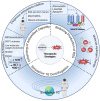Oxidative Stress on the Ground and in the Microgravity Environment: Pathophysiological Effects and Treatment
- PMID: 40002415
- PMCID: PMC11852023
- DOI: 10.3390/antiox14020231
Oxidative Stress on the Ground and in the Microgravity Environment: Pathophysiological Effects and Treatment
Abstract
With the continued exploration of the universe, there is an increasingly urgent need to address the health challenges arising from spaceflight. In space, astronauts are exposed to radiation, confinement and isolation, circadian rhythm dysregulation, and microgravity conditions that are different from those on Earth. These risk factors jeopardize astronauts' health, thus affecting the quality of space missions. Among these factors, gravitational changes influence the balance between oxidation and antioxidants, stimulating the production of reactive oxygen species (ROS), finally leading to oxidative stress (OS). OS leads to oxidative damage of biomolecules such as lipids, proteins, and DNA, which causes the development of various diseases. The occurrence of OS is increased in microgravity and affects multiple systems, including the musculoskeletal, cardiovascular, nervous, and immune systems. In this review, we discuss the mechanisms of OS, the physiological effects on different systems caused by OS in microgravity environment, and potential treatments for OS. Finally, treatment strategies for oxidative stress in microgravity are summarized, providing some promising approaches for protecting the health of astronauts in future space exploration.
Keywords: antioxidants; microgravity; oxidative stress; reactive oxygen species; therapy.
Conflict of interest statement
The authors declare no conflicts of interest.
Figures


Similar articles
-
Oxidative Damage Under Microgravity Conditions: Response Mechanisms, Monitoring Methods and Countermeasures on Somatic and Germ Cells.Int J Mol Sci. 2025 May 10;26(10):4583. doi: 10.3390/ijms26104583. Int J Mol Sci. 2025. PMID: 40429729 Free PMC article. Review.
-
The effects of real and simulated microgravity on cellular mitochondrial function.NPJ Microgravity. 2021 Nov 8;7(1):44. doi: 10.1038/s41526-021-00171-7. NPJ Microgravity. 2021. PMID: 34750383 Free PMC article. Review.
-
Key points for the development of antioxidant cocktails to prevent cellular stress and damage caused by reactive oxygen species (ROS) during manned space missions.NPJ Microgravity. 2021 Sep 23;7(1):35. doi: 10.1038/s41526-021-00162-8. NPJ Microgravity. 2021. PMID: 34556658 Free PMC article. Review.
-
Thymus ad astra, or spaceflight-induced thymic involution.Front Immunol. 2025 Jan 24;15:1534444. doi: 10.3389/fimmu.2024.1534444. eCollection 2024. Front Immunol. 2025. PMID: 39926601 Free PMC article. Review.
-
Neuro-consequences of the spaceflight environment.Neurosci Biobehav Rev. 2022 Jan;132:908-935. doi: 10.1016/j.neubiorev.2021.09.055. Epub 2021 Nov 9. Neurosci Biobehav Rev. 2022. PMID: 34767877 Review.
Cited by
-
Oxidative Damage Under Microgravity Conditions: Response Mechanisms, Monitoring Methods and Countermeasures on Somatic and Germ Cells.Int J Mol Sci. 2025 May 10;26(10):4583. doi: 10.3390/ijms26104583. Int J Mol Sci. 2025. PMID: 40429729 Free PMC article. Review.
-
Cell biomechanics on muscle atrophy: from intricate mechanisms to therapeutic frontiers.Ann Med. 2025 Dec;57(1):2540598. doi: 10.1080/07853890.2025.2540598. Epub 2025 Aug 1. Ann Med. 2025. PMID: 40747836 Free PMC article. Review.
References
-
- Afshinnekoo E., Scott R.T., MacKay M.J., Pariset E., Cekanaviciute E., Barker R., Gilroy S., Hassane D., Smith S.M., Zwart S.R., et al. Fundamental biological features of spaceflight: Advancing the field to enable deep-space exploration. Cell. 2020;183:1162–1184. doi: 10.1016/j.cell.2020.10.050. - DOI - PMC - PubMed
Publication types
Grants and funding
LinkOut - more resources
Full Text Sources

